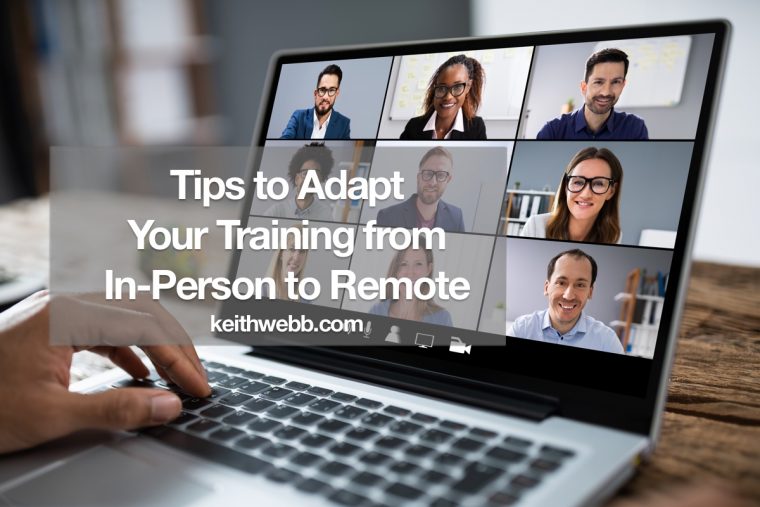Remote training events can be even more effective than their in-person counterparts. But, you can’t just duplicate the in-person event using Zoom. Here’s how to successfully adapt your training events from in-person to remote.

I’ve clocked more hours on Zoom lately than meeting with people in person. There can be too much of a good thing, however. Zoom fatigue is real. I wrote about how to mix your modes of meeting to remain productive. Here, I’d like to address how to make Zoom work for extended meetings.
With the change from in-person to remote training events, we’ve seen some done well and some done poorly. The events that are a duplicate of an in-person experience often flop.
Adapting a training workshop from in-person to remote requires rethinking your event in light of the new medium of delivery.
Adapting a workshop from in-person to remote requires rethinking your event in light of the new medium of delivery. Share on XAdapt Your Training from In-Person to Remote
We changed our in-person Coaching Mastery Certificate Program to fully live on Zoom. We’ve now run it a number of times and have learned a lot. Here are our main tips to adapt your training from in-person to Zoom.
- Don’t do all-day Zoom meetings. Reduce your content or do the meeting over multiple days. We divided the in-person part of Coaching Mastery into eight 4.5-hour and two 2-hour sessions running over two weeks. It has intensity, but also plenty of off screen time to process the material. Intensity with processing time promotes learning and application.
- Schedule short breaks every hour. We schedule 10-minute and 20-minute breaks every 50-55 minutes. Breaks allow people to physically move, going for a restroom break or a cup of coffee. But not enough time that you lose the person to other work, like a 30-minute+ break would.
- Keep lectures short. Our rule of thumb for lectures is 15 minutes maximum before changing the activity. Rework your training to reduce lecture time. Also, add a second voice by having someone else present part of the content.
- Use active learning. Everyone likes interactive, active learning. Go beyond the usual small group discussions with these 10 ideas for active learning.
- Use the interactive technology. Surprisingly, I like Zoom breakout rooms for practice better than in-person. Use them for discussion, activities, and practice. Turn on cameras. Use the Chat box for quick responses. Share a video. Share your screen to demonstrate how to find or do something on a computer. Use other interactive, Internet-based tools out there.
- Make it valuable. Just because Zoom didn’t cost your participants time and money for travel, doesn’t justify not having a sharp, practical, relevant, and interactive program. Participants don’t get all the side conversations on breaks, so you need to make sure your program is all the more valuable!
After doing the Coaching Mastery Certificate Program fully online, we have found that participants are getting more out of it in this format. They are completing the program with higher levels of coaching skills than when we did it in-person.
With a bit of creativity, you can adapt your in-person training to Zoom and see great results. Go for it!
Share your experience and tips below.


Please note: I reserve the right to delete comments that are offensive or off-topic. You own your comments but give me permission to use them. See My Comments Policy. Read my Permissions Policy to know how you can use my posts.